The State Department has approved an $80 million military aid package to Taiwan. Though hardly a military game-changer, this modest transfer is unprecedented in its funding source: the Foreign Military Financing (FMF) program, which is primarily a grant account for military assistance to foreign countries.
The transfer, the State Department insists, does not imply the recognition of Taiwan as a sovereign state. "Consistent with the Taiwan Relations Act and our longstanding One China policy, which has not changed, the United States makes available to Taiwan defense articles and services necessary to enable it to maintain a sufficient self-defense capability," a State Department spokesperson said.
Yet the FMF grant follows a consistent pattern of rhetoric and behavior that appears to dilute strategic ambiguity, or the longstanding U.S. policy of deliberately maintaining uncertainty around the question of whether the U.S. would intervene militarily to defend Taiwan from Chinese attack. President Joe Biden explicitly stated, and reaffirmed in response to a clarifying question from 60 Minutes correspondent Scott Pelley, in September 2022 that U.S. forces will fight to defend Taiwan in the event of a Chinese invasion.
The ongoing dilution of strategic ambiguity as a credible foreign policy concept, accompanied by a sharp and rapid decline in the overall U.S.-China relationship, raises the specter of military confrontation in the Taiwan Strait. Now more than ever, there is a pressing need to articulate a viable vision not only on Taiwan policy but on the broader issues surrounding the U.S. defense posture in the Asia-Pacific. To unpack the dynamics of the Taiwan conflict and what it means for U.S. strategy, it is worth revisiting an age-old concept of international politics: the security dilemma.
The security dilemma, in short, holds that actions taken by states to increase their security can be perceived as threatening by other states, triggering a chain reaction that makes everyone involved less safe. It is a foundational idea in international relations thinking, and for good reason. It speaks to a deeply salient aspect of state behavior, observed over the course of thousands of years from the Peloponnesian War onwards and extensively reproduced in numerous geopolitical contexts.
The dilemma has been most clearly and frequently expressed through cases of military buildup. Imagine a scenario in which you, as a leader, have come to believe that your neighbor harbors aggressive intentions toward your country. Your belief may be premised, as these situations so often are, on decades or even centuries of bad blood including real acts of aggression previously committed by your neighbor. So, you resolve to arm yourself to deter and, if need be, repel your neighbor’s aggression.
But it turns out that you are not the only one driven by such fears. Your neighbor, informed by their own history, interests, and strategic culture, believes something awfully similar about you and concludes that your defensive buildup is a prelude to an attack on them. They might respond with a buildup of their own, thus heightening the risk of miscalculation and catastrophic accident, or by launching a preemptive strike on you.
The Taiwan situation is, admittedly, more complex than a simple border buildup crisis between two contiguous powers because it is a maritime conflict centered on a third actor that, despite not being recognized by Washington as a sovereign country, is widely considered key to U.S. regional and global interests. Yet the basic logic outlined by the security dilemma not only still applies but is more relevant than ever to understanding what makes the Taiwan conflict so dangerous and difficult to solve. Taiwan is the geopolitical fulcrum between competing Chinese and U.S. spheres of influence in the Asia-Pacific.
Any U.S. effort to impose military costs on a potential Chinese invasion of Taiwan, or even to maintain relations with Taipei, will be bemoaned by Beijing as an attempt to “strangle” China and runs the risk of incurring reciprocal Chinese military actions. The security dilemma over Taiwan is, as former Pentagon official and Principal of the Marathon Initiative Elbridge Colby rightly observes, both real and unavoidable, but it need not lead to catastrophe. The dilemma cannot be solved outright, but it can and should be mitigated.
Colby and others advocating for a more proactive Asia-Pacific policy are correct in their assessment that the train has left the station when it comes to strategic ambiguity. Chinese strategy is likely already premised on the assumption, increasingly reflected in American foreign policy discourse and military planning, that U.S. forces will directly intervene to defend Taiwan. Strategic ambiguity was a masterstroke of American diplomacy, guaranteeing Taiwan’s integrity and advancing U.S. regional interests for over 50 years at exceedingly low cost and with little risk.
But the veil has been lifted. The conditions in which strategic ambiguity thrived are not sustainable, not least of all because the Chinese, as the primary audience for which the message of ambiguity was designed, no longer view it as a credible sentiment. The illusion of ambiguity has been dispelled and cannot be recreated in the context of present U.S.-China relations.
In thinking about solutions, it is important to highlight that strategic ambiguity and the One China Policy, though historically intertwined, are not and have never been a package deal. It is fully possible to acknowledge Taiwan’s vital importance to U.S. interests and to act accordingly without recognizing it as a sovereign country. Recognition would bolster China’s pretext for an invasion and massively increase the likelihood of a military showdown over Taiwan. Actions that can be interpreted as a signal that U.S. policymakers are mulling recognition, such as the recent FMF transfer, needlessly risk a disproportionate Chinese response.
This is not to suggest that there isn’t room for deterrence in the U.S. policy toolkit. Indeed, there is both military and political value in aiding Taiwan with the goal of conveying to Beijing that any attempt at “reunification” through force will be the opposite of quick and painless. But such efforts, while worthwhile, must be accompanied by a coherent and realistic Asia-Pacific strategy that leverages the unique advantages offered by America’s regional alliances and balances competition with engagement where appropriate.
Our rhetoric and policies on Taiwan should be firm, not bombastic; predictable, not shrill; and guided by concrete material interests, not the promulgation of abstract values. Asia-Pacific is the theater where the configuration of the international order will be decided in coming years and decades. There is no greater strategic challenge confronting American policymakers than to manage the Taiwan crisis in a judicious and forward-looking manner — U.S. global standing hinges on it.
- Sen. Rand Paul: My colleagues are 'beating the drums' for 'war with China' ›
- Biden trashes what remained of US One China policy, strategic ambiguity ›
- War with China over Taiwan won't end well for anyone ›
- War with China over Taiwan? Don't expect US allies to join ›
- Why we shouldn't declare Taiwan an independent country - Responsible Statecraft ›
- Is China's military the Goliath it's portrayed to be? - Responsible Statecraft ›















